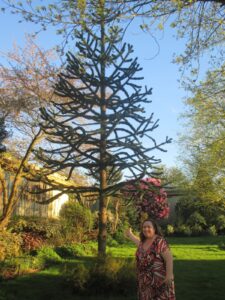Context Monkey Puzzle Tree:

(Photo Credit Jen Dawkins March 2016)
Monkey Puzzle trees look like a Dr. Seuss illustration of a tree come to life. In 1993 there were at least 150 trees of this variety in Portland—at least a third of those had “roots” in Slabtown. The Monkey Tree (Araucaria araucana) is native to Chile, and like our historic homes its numbers are dwindling. The males have oblong cones and the females have round cones—all of our city’s heritage trees of this type are male. In their native Chilean mountain habitat they can reach a height of 100 feet and can live for 2,000 years.
Chile’s national tree, which dates back to the dinosaur era, is listed as ‘endangered’ on the International Union for Conservation of Nature’s Global Red List of Conifers. In their native habitats these trees have suffered from climate change and massive fires in 2001–02 and 2014 have reduced their numbers by 50%. There are a number of active online groups mapping the locations of the trees in our city and a Facebook Group “Monkey Puzzle Trees of PDX“.
Question:
The seedlings of Portland’s Heritage Monkey Puzzle Trees citywide can trace their origins to what Slabtown Event?
Answer:
The 1905 Lewis and Clark Centennial Exposition, where seedlings were given away by a representative from Chile and planted by their recipients citywide. Three Monkey Puzzle Trees from the Fair are protected heritage trees standing at 419 NE Hazelfern, 415 NE Laurelhurst, and 446 NE Fargo. Link to map of these trees in Oregon created by Carol Studenman:
(The two best 1905 examples of Monkey Puzzle Trees are in Laurelhurst.)
Fun Facts are produced monthly by Tanya Lyn March PhD owner of Slabtown Tours to join our mailing list simply e-mail: slabtowntours@gmail.com.
